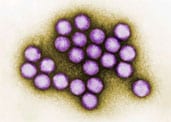Purpose
The National Adenovirus Type Reporting System (NATRS) is a passive laboratory-based surveillance system that coordinates reporting of laboratory detections of human adenovirus types in the United States.

Overview
CDC encourages participating laboratories to report typed human adenovirus detections accompanied by limited demographic, clinical, and laboratory data.
Type-based human adenovirus surveillance in the United States has three objectives:
- Determine circulation patterns of human adenovirus types.
- Assist with recognition and confirmation of outbreaks associated with circulating types.
- Inform development or use of diagnostic tests, therapeutics, and vaccines.
Participating sites
Since 2017, six laboratories from across the United States have reported data to NATRS:
- The CDC Respiratory Virology Laboratory
- Public health laboratories from four states
- One Department of Defense laboratory
What data we collect
Data are collected from collaborating public health and clinical laboratories in the United States. Laboratories report human adenovirus detections on a quarterly basis to CDC by:
- species and human adenovirus type
- specimen type
- collection date
- age
- sex
NATRS collects data from participating laboratories using a simplified report form. This allows for determination of trends in type-specific human adenovirus circulation and more timely recognition and documentation of outbreaks.
Laboratories with the capacity to type are encouraged to report to NATRS to help improve geographic and temporal surveillance.
Surveillance data
Most Common Human Adenovirus Species and Types Reported in the U.S., 2014-2017
Species and Type and (Percent of Detections)
- A12 (0.3); A31 (0.3
- B3 (22.3); B7 (12.9); B11 (0.2); B14 (4.1)
- B21 (1.6); B34 (0.2); B35 (0.5)
- C1 (14.7); C2 (19.6); C5 (3.4); C6 (1.2)
- D8 (3.4); D15 (0.1); D19 (0.2); D22 (0.1)
- D29 (0.1); D37 (0.7); D53 (0.6); D56 (0.1)
- E4 (13.4)
- F41 (0.2)
Detections were reported in specimens from 32 states and the U.S. Virgin Islands.
For more information about the most recent human adenovirus data, see CDC MMWR Human Adenovirus Surveillance – United States, 2003-2016.
Publications
NATRS data are made available to public health professionals, health care providers, and the public.
- Probst, Varvara, et al. "Clinical presentation and severity of adenovirus detection alone vs adenovirus co-detection with other respiratory viruses in US children with acute respiratory illness from 2016 to 2018." Journal of the Pediatric Infectious Diseases Society 11.10 (2022): 430-439.
- CDC. Human Adenovirus Surveillance — United States, 2003–2016. MMWR Morb Mortal Wkly Rep. 2017;66(39):1039-42.
- Scott, M.K., et al. Human Adenovirus Associated with Severe Respiratory Infection, Oregon, USA, 2013-2014. Emerg Infect Dis. 2016; 22(6):1044-51.
- Killerby ME, Stuckey, MJ, Guendel, I, et al. Notes from the Field: Epidemic Keratoconjunctivitis Outbreak Associated with Human Adenovirus Type 8 — U.S. Virgin Islands, June–November 2016. MMWR Morb Mortal Wkly Rep. 2017; 66:811–812
